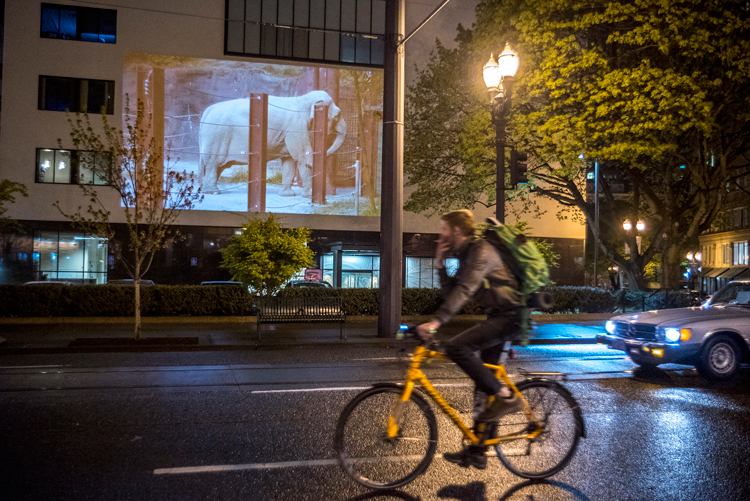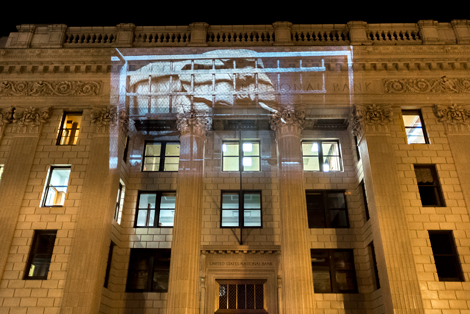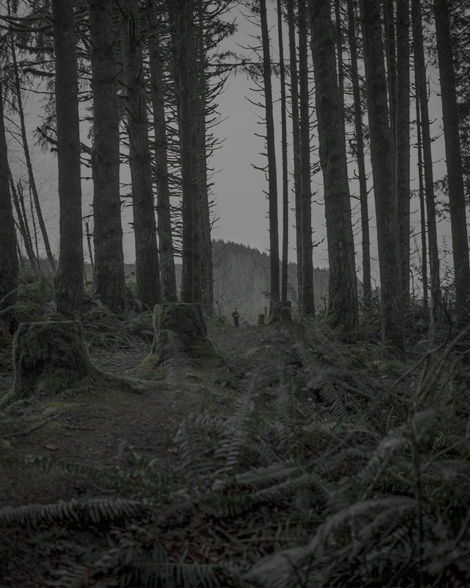Each April, galleries in Portland, OR, exhibit photography in recognition of Photo Month. As one might expect from a small art scene, the exhibitions are locally important but seem nostalgic, derivative or touristic to outsiders. The two notable exceptions are Coleen Plumb at Blue Sky, and David Hillard at Elizabeth Leach Gallery.
Plumb pushes photography’s taxonomical quality, presenting animal imagery in the broadest sense. Her work captures the social and emotional value of fauna while complicating the installation with her video, Thirty Times a Minute, which depicts “weaving,” a self-destructive behavior exhibited by elephants maintained in captivity for human amusement. Plumb pushes her message outside the gallery walls, projecting her video onto local buildings and scenic waterfalls.

David Hilliard, Final Destination, 2015. archival pigment print, 24 x 60” triptych; each panel 24 x 20”; Edition of 12. Image courtesy of the artist and Elizabeth Leach Gallery.
Hillard’s exhibition was a small retrospective of his cinematic, multi-panel images. Mostly known for explorations of gay male desire, his diverse range was on full display. Final Destination depicts an RV decorated with an idealized image of the same rocky terrain that surrounds it. This campy take on the modern carriage thrives on the inaccessible stories of its unknown.
The gallery exhibitions set the stage for Photolucida, a festival that brings 160 photographers to town for critiques with high profile photo professionals from around the world. While there are a few public events, notably Mona Kuhn’s keynote address, people line the block outside the Portland Art Museum for the Portfolio Walk during which each of the 160 participating photographers stand next to their portfolios and discuss their work with the public. Once the event fills to capacity, a new viewer can only be admitted as somebody else leaves. With work presented through the night in three one-hour shifts, only the most dedicated will see all 160 portfolios. Participants are said to be mid-career, but without vetting from Photolucida, there were numerous hobbyists and at least one undergraduate. The sheer volume of work, however, provides something for everyone.
I saw two promising artists using radiation to different effect. Abbey Hepner uses uranyl nitrate as the light sensitive agent in her photographs of radioactive waste storage facilities. The prints are contaminated with radioactivity. Like the warehouses that store the waste, her images appear innocuous, so she sometimes displays the work with the wand of a Geiger counter resting on a single print, providing the creaking pulsation of hidden danger. David Ondrik places metal objects on photographic paper inside a microwave oven. The resulting flashes expose more or less random patterns with a vaguely referential resonance punctuated by fuzzy bursts of white.
Chris Bennett’s desaturated landscapes depict nature as simultaneously overwhelming and majestic, yet stripped of life. One might assume either a dialog of sustainability and depleted resources or of vampiric force draining the forests of forgotten lore. The gothic quality of his day-for-night shooting far exceeds the sometimes traditional compositions.
Photo Month in Portland will probably never have the draw of a major art fair, but it opens a dialog, if only briefly, about the multitude of possibilities within the photographic medium while providing a worthwhile convergence of aspiring photographers and an aspiring art scene.






